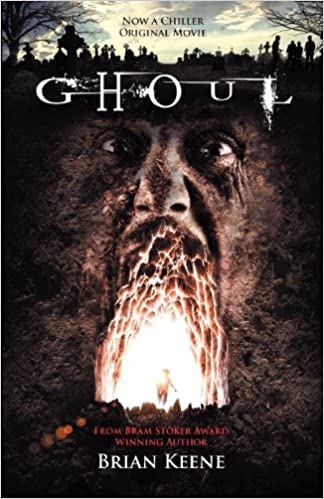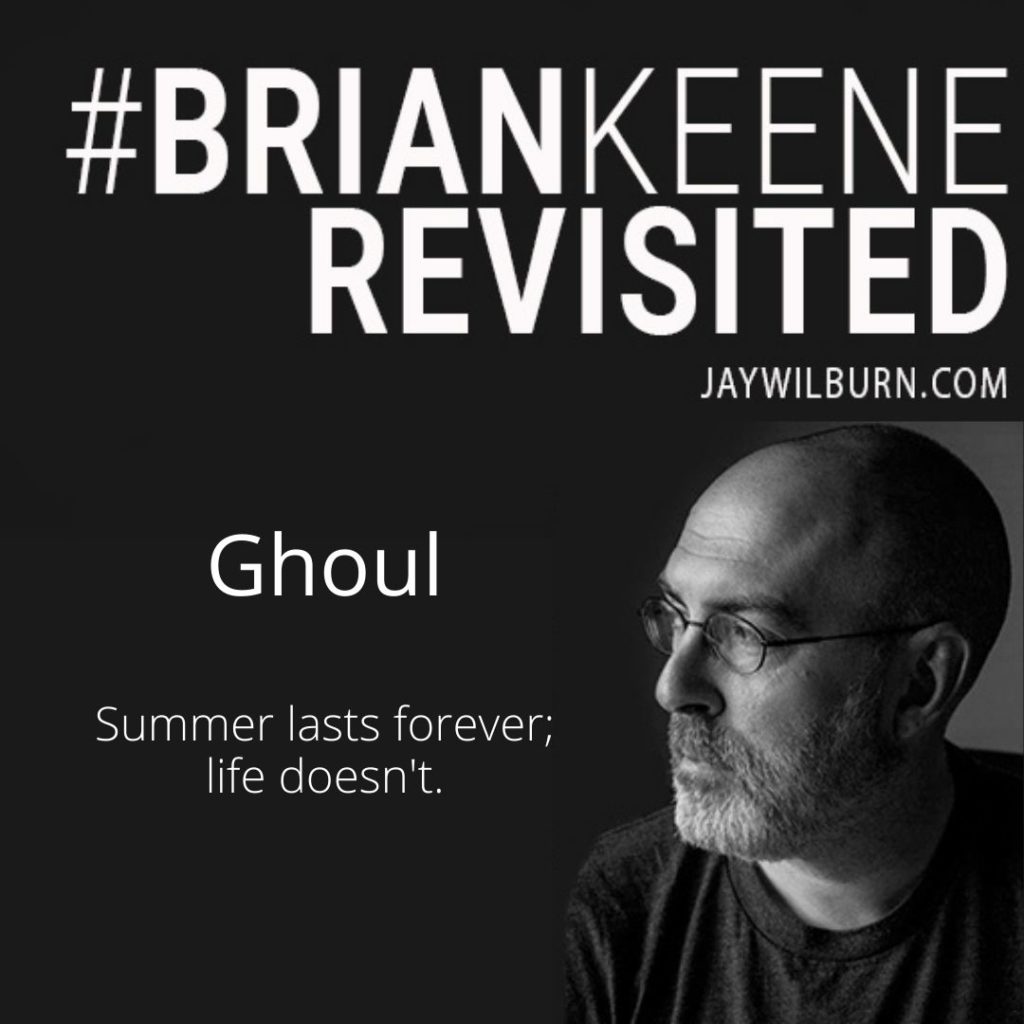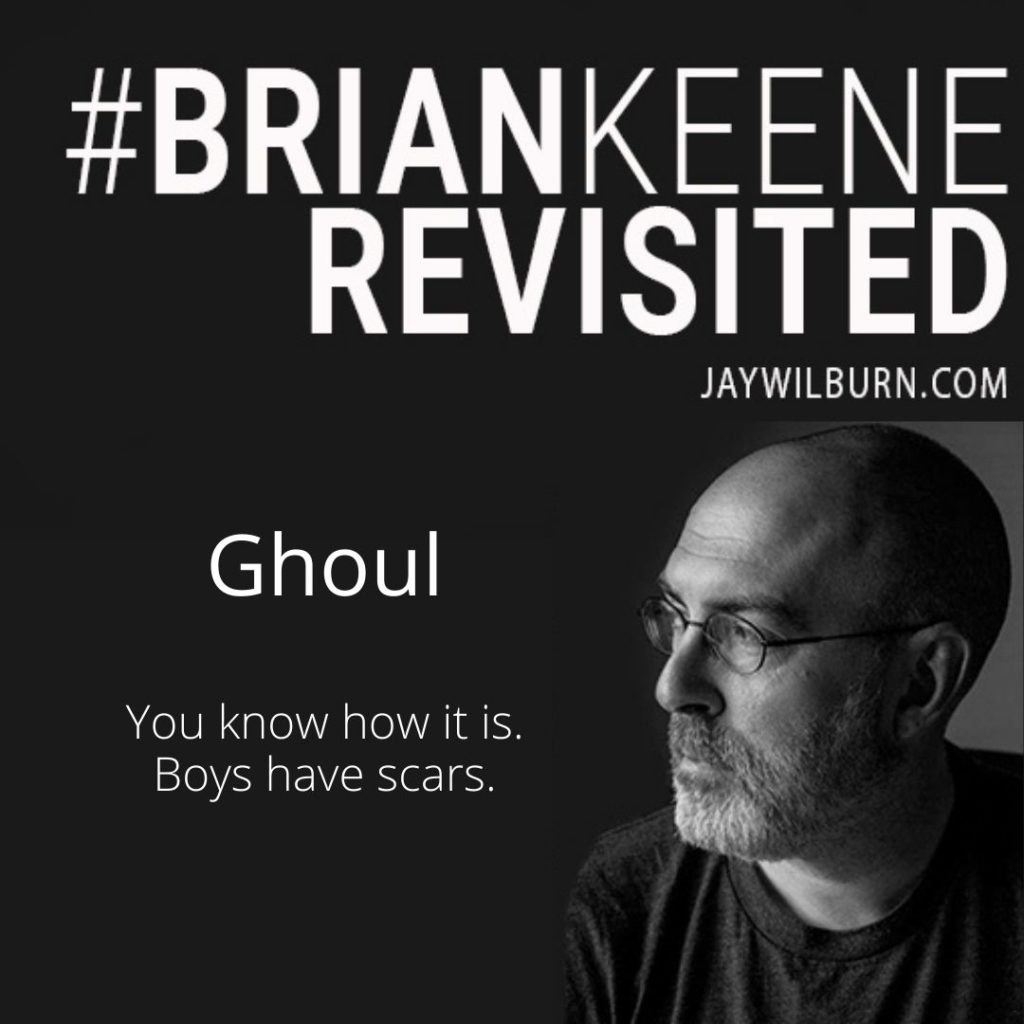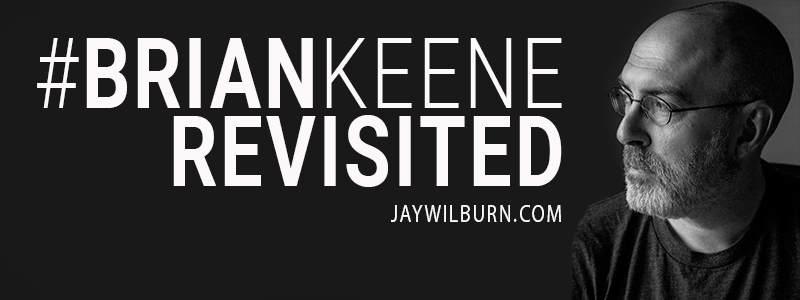by Jay Wilburn
The plan is to reread all of Brian Keene’s available works in roughly the order that they were published. I’m doing it because I’m an author in need of improvement and a reader who enjoys a storyteller willing to bleed out on the page in a powerful and interesting way. I’m a fan of Keene’s work. I think there is something to be learned through this process.
You can also go back to the Introductory Post: A Gathering of Books to read more about the how and the why of this or any of my other posts up through this one and beyond by checking out the Master List of all my #BrianKeeneRevisited posts.

Reading details of Brian Keene’s life revealed more directly in later writings, we see his history and experiences remixed all through Ghoul. But that’s what all great Keene books ultimately are.
Ghoul stood out in my mind as the darkest of dark books. A lot of bad stuff happens to the young characters from the supernatural to ordinarily horrific. Upon rereading it, maybe I was braced for the darkness and brutality, but I wasn’t as shocked this time through. Knowing what’s coming is part of it. Reading more Keene books with more and more creative unhappy endings may have inoculated me to the horrors of this book. There is still great emotional strength to the twists and turns of this story and those resonated more strongly with me than the pure horror. That sort of thing has to be blamed on the age of the reader, I guess. This reader has aged beyond his years and has been through some shit himself. Who hasn’t though?
Keene found himself in a dark personal place leading into the writing of this story. It was hinted at in his nonfiction, but he would not reveal all he was suffering during this time period until much later. He decided to dive into the traumas of childhood to feed the darkness that made the bones of this novel. None of that’s new for Keene either by this point.

We are entrenched in Brian Keene’s 1984 for the outset of the story. Not the classic dystopian novel, but the actual year. Every song and comic book reference are flawlessly accurate. “Purple Rain” reigns supreme in Keene’s development and in this story opening. Pat doesn’t appreciate it quite as much as Keene did in his time, except for getting the girl in the mood in the fateful cemetery. Thundarr the Barbarian gets its due in the story as well. Going from 1984 from the perspective of blossoming teens to the lighter perspective of a kid when innocence is still held for a moment longer, adds a sharp contrast to the dark scene that opens the book. It’s enough to lull you into letting your guard down to believe the illusion that everything might be fine for a while.
“Wouldn’t be a cemetery without them.” Great line.
The setting is immersive beyond the time specific details. It speaks to Keene drawing from his own life to create a world that feels real. It also speaks to his ability to pepper in sensory details that don’t weigh down the flow of the story, but pull us into the world itself.
LeHorn, from Dark Hollow, gets a couple shoutouts in Ghoul. The dark folk magic of powwow is in play again and LeHorn as a practitioner before his story turned violent is known for it. He attended a funeral in this story as well. Of course, we hear of the Long Lost Friend again as well.
We also get references to the hierarchy of the mythos of Keene’s universe and the place this story’s threat holds in it.
Summers were endless; life was not. — Beautiful paradox more true than literal truth. Great line.
“The dead slept too, but did not dream.” This line kicks off an aside sort of chapter that could have been cut from the story, but I really loved it. In Stephen King’s The Stand, there is one such chapter where King explores the unfortunate deaths of others who survived the initial outbreak in that novel. I’ve occasionally gone back just to read that chapter for its value as a standalone tale. Keene accomplishes something similar as he plays out the lives and deaths of the bodies in the cemetery. In these early pages where the nature of the threat has not yet been revealed, it is still possible these aside characters might play a role in the larger tale in all sorts of dark ways. Keene will shortly show you the role they play, maybe darker than our initial guesses. Great chapter greatly used.
The small subtle relationship between Timmy and Katie is artfully done and placed in the story. Keene has written children well for all his career. Relationships between boys and their fathers in all their facets is where he shines above most other authors I can name, but writing children characters well in general is a strong skill for him. The relationship between the three boys is testament to that. But with Timmy and Katie, going that light and delicate with Timmy’s relationship here in the midst of a book full of horrors is incredibly insightful as a storyteller. It is a level of finesse that separates the great from the pretty good. He doesn’t spend more time than he needs to. He doesn’t cheapen it by making it too cute or a bigger story point than it is. In the light touch he applies here, like the lightness of the introduction of the Timmy himself, he defines a world where the small milestones of early youth are mixed with the gut-wrenching realities of the darkness that occurs behind closed doors, where the real monsters reveal themselves. A little more or a little less would have broken this magic.
Likewise, the comic book scene in the basement hit harder than it should have, considering everything else going on in the story. It was a relatable scene for many people who were young in the era. And it was such a hard turn from where the scene started emotionally. Another masterclass from the writer on creating a scene that punches above its weight.

The final act varies in its tone and pacing in the best ways, but becomes a race to a crash ending between all the characters at play. The action is spot on. He writes heroes, but not superheroes that would defuse the horror by having things go too well. And this is Brian Keene: there will be a price to pay.
Aside from nailing the end of the story in terms of the action, Brian Keene resolves the tale to any reader’s satisfaction without putting a bow on every plot point and character. There was a lot of aftermath, but we didn’t need to see all of it to understand what happened. Lesser authors would have indulged one more beat for every character to wrap up the scars and wounds left behind by choices made. There is enough there that we know how it went for everyone and Keene doesn’t insult our intelligence by presuming we can’t figure it out from what he gave us without spelling everything out.
“You know how it is. Boys have scars.” My God, what a way to end it. There might be overtly darker or bloodier endings throughout Keene’s catalog, but have I seen an author do more with simply having kids grow up to be like their fathers in one way or another? Not that I can recall.
Ghoul is the favorite book of many diehard Brian Keene fans for good reason.
My next post in this series will be The Rising: Selected Scenes from the End of the World #BrianKeeneRevisited which can be found on the Master List of all my #BrianKeeneRevisited posts. Note: The photo of Brian Keene used in the banner image of these blog posts was taken by John Urbancik and used by permission of both Keene and Urbancik.






This is my favorite book by Brian next to Terminal. It’s his ultimate coming of age story much like Stephen King’s IT. He just nailed that era and I also love the dugout. My friends and I had a similar hangout when we were kids but it wasn’t half as cool as the dugout. I love the story that he tells about how he found his old dugout in his old neighborhood as an adult and it was a big part of the inspiration to write this book.
Doug was just a heart-breaking, tragedy of a character. I cringed so bad during those scenes with his mom. And Barry’s dad was a great villain. It’s so sad at the end when you find out that Barry, instead of overcoming the sins of his father, actually becomes his father. I myself had a really rocky relationship with my dad growing up as he was a very flawed human being and I made it my life’s goal to not be like him. So because of that, it was a REALLY hard part for me to read. You root for him and hope he can break the cycle and then he just can’t.
I also love the ghoul creature in the overall Keene mythos, and actually pitied him by the end of the book because all he was really trying to do at the end of the day was just preserve his race. I like that little detail that Brian threw in there. Makes you care a little bit for the monster. I can’t say enough great things about this book. It’s one I always recommend to somebody who is new to Brian’s work. Instead of The Rising from which he is probably best known for by a lot of people who don’t read a lot of his stuff, I always recommend books like Terminal, Dark Hollow, and Ghoul. He’s definitely really started hitting his stride as a storyteller with this one.
I love this one too for all the reasons you name. It only got better with the reread. It’s pretty amazing to me that he was this good through the early phase of his publishing career.